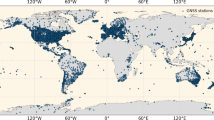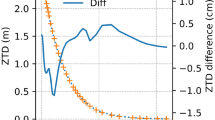Abstract
Most of the space-geodetic observation techniques can be used for modeling the distribution of free electrons in the Earth’s ionosphere. By combining different techniques one can take advantage of their different spatial and temporal distributions as well as their different observation characteristics and sensitivities concerning ionospheric parameter estimation. The present publication introduces a procedure for multi-dimensional ionospheric modeling. The model consists of a given reference part and an unknown correction part expanded in terms of B-spline functions. This approach is used to compute regional models of Vertical Total Electron Content (VTEC) based on the International Reference Ionosphere (IRI 2007) and GPS observations from terrestrial Global Navigation Satellite System (GNSS) reference stations, radio occultation data from Low Earth Orbiters (LEOs), dual-frequency radar altimetry measurements, and data obtained by Very Long Baseline Interferometry (VLBI). The approach overcomes deficiencies in the climatological IRI model and reaches the same level of accuracy than GNSS-based VTEC maps from IGS. In areas without GNSS observations (e.g., over the oceans) radio occultations and altimetry provide valuable measurements and further improve the VTEC maps. Moreover, the approach supplies information on the offsets between different observation techniques as well as on their different sensitivity for ionosphere modeling. Altogether, the present procedure helps to derive improved ionospheric corrections (e.g., for one-frequency radar altimeters) and at the same time it improves our knowledge on the Earth’s ionosphere.
Similar content being viewed by others
References
Azpilicueta F, Brunini C (2009) Analysis of the bias between TOPEX and GPS vTEC determinations. J Geodesy 83(2): 121–127
Azpilicueta F, Brunini C, Radicella SM (2006) Global ionospheric maps from GPS observations using modip latitude. Adv Space Res 38: 2324–2331
Bergstrand S, Haas R (2004) Comparison of ionospheric activity derived from GPS and different VLBI networks. IVS general meeting proceedings, pp 447–451
Bilitza D, Reinisch BW (2008) International reference ionosphere 2007: improvements and new parameters. Adv Space Res 42(4): 599–609
Brunini C, Meza A, Bosch W (2005) Temporal and spatial variability of the bias between TOPEX- and GPS-derived total electron content. J Geodesy 79(4-5): 175–188
Brunini C, Meza A, Gende M, Azpilicueta F (2008) South American regional ionospheric maps computed by GESA: A pilot service in the framework of SIRGAS. Adv Space Res 42(4): 737–744
Dettmering D (2003) Die Nutzung des GPS zur dreidimensionalen Ionosphärenmodellierung. Department of Geodesy and Geoinformatic Stuttgart, University of Stuttgart, Stuttgart
Dettmering D, Heinkelmann R, Schmidt M (submitted) Systematic differences between VTEC obtained by different space-geodetic techniques during CONT08. J Geodesy
Dow JM, Neilan RE, Rizos C (2009) The international GNSS service in a changing landscape of Global Navigation Satellite Systems. J Geodesy 83: 191–198
Fong C-J, Yen NL, Chu C-H, Yang S-K, Shiau W-T, Huang C-Y, Chi S, Chen S-S, Liou Y-A, Kuo Y-H (2009) FORMOSAT-3/COSMIC spacecraft constellation system, mission results, and prospect for follow-on mission. Terr Atmos Ocean Sci 20: 1–19
Hajj GA, Ibañez-Meier R, Kursinski ER, Romans LJ (1994) Imaging the ionosphere with the Global Positioning System. Int J Imag Syst Technol 5: 174–184
Hernández-Pajares M, Juan JM, Sanz J, Orus R, Garcia-Rigo A, Feltens J, Komjathy A, Schaer SC, Krankowski A (2009) The IGS VTEC map: a reliable source of ionospheric information since 1998. J Geodesy 83(3-4): 263–275
Hobiger T, Kondo T, Schuh H (2006) Very long baseline interferometry as a tool to probe the ionosphere. Radio Sci 41(1): RS1006
Hugentobler U, Schaer S, Beutler G, Bock H, Dach R, Jäggi A, Meindl M, Urschl C, Mervart L, Rothacher M, Wild U, Wiget A, Brockmann E, Ineichen D, Weber G, Habrich H, Boucher C (2002) CODE IGS Analysis Center Technical Report 2002
IERS (2010) IERS Conventions update, web resource. http://tai.bipm.org/iers/convupdt/convupdt/c9.html
Iijima BA, Harris IL, Ho CM, Lindqwister UJ, Mannucci AJ, Pi X, Reyes MJ, Sparks LC, Wilson BD (1999) Automated daily process for global ionospheric total electron content maps and satellite ocean ionospheric calibration based on Global Positioning System. J Atmos Solar Terr Phys 61(16): 1205–1218
Jakowski N, Wehrenpfennig A, Heise S, Reigber Ch, Lühr H, Grunwaldt L, Meehan TK (2002) GPS radio occultation measurements of the ionosphere from CHAMP: Early results. Geophys Res Lett 29(10): 10.1029/2001
Koch KR, Kusche J (2002) Regularization of geopotential determination from satellite data by variance components. J Geodesy 76(5): 259–268
Langley RB (1998) Propagation of the GPS Signals Chap, 3. In: Teunissen PJG, Kleusberg A (eds) GPS for Geodesy. Springer, Berlin
Picot N, Case K, Desai S, Vincent P (2008) AVISO and PODAAC User Handbook. IGDR and GDR Jason Products, edn. 4.1. Report SMM-MU-M5_OP-13184-CN (AVISO), JPL D-21352 (PODAAC)
Sánchez L, Brunini C (2009) Achievements and Challenges of SIRGAS, IAG Symposia, vol 134. Springer, Berlin pp, pp 161–166
Schlüter W, Behrend D (2007) The International VLBI Service for Geodesy and Astrometry (IVS): current capabilities and future prospects. J Geodesy 81(6–8): 379–387
Schmidt M (2007) Wavelet modelling in support of IRI. Adv Space Res 39(5): 932–940
Schmidt M, Karslioglu MO, Zeilhofer C (2008) Regional multi-dimensional modeling of the ionosphere from satellite data. Proceedings of the TUJK Annual Scientific Meeting, Ankara
Sekido M, Kondo T, Kawai E, Imae M (2003) Evaluation of GPS-based ionospheric TEC map by comparing with VLBI data. Radio Sci 38(4), p 1069. doi:10.1029/2000RS002620
Todorova S, Schuh H, Hobiger T, Hernández-Parajes M (2007) Global models of the ionosphere obtained by integration of GNSS and satellite altimetry data. Österreichische Zeitschrift für Vermessung und Geoinformation (VGI) 2: 80–89
Wilson BD, Mannucci AJ (1994) Extracting ionospheric measurements from GPS in the presence of anti-spoofing. Proceedings of the ION GPS-94, Salt Lake City
Zeilhofer C (2008) Multi-dimensional B-spline Modeling of Spatio-temporal Ionospheric Signals. DGK Reihe A123 Deutsche Geodätische Kommission, München
Author information
Authors and Affiliations
Corresponding author
Rights and permissions
About this article
Cite this article
Dettmering, D., Schmidt, M., Heinkelmann, R. et al. Combination of different space-geodetic observations for regional ionosphere modeling. J Geod 85, 989–998 (2011). https://doi.org/10.1007/s00190-010-0423-1
Received:
Accepted:
Published:
Issue Date:
DOI: https://doi.org/10.1007/s00190-010-0423-1




